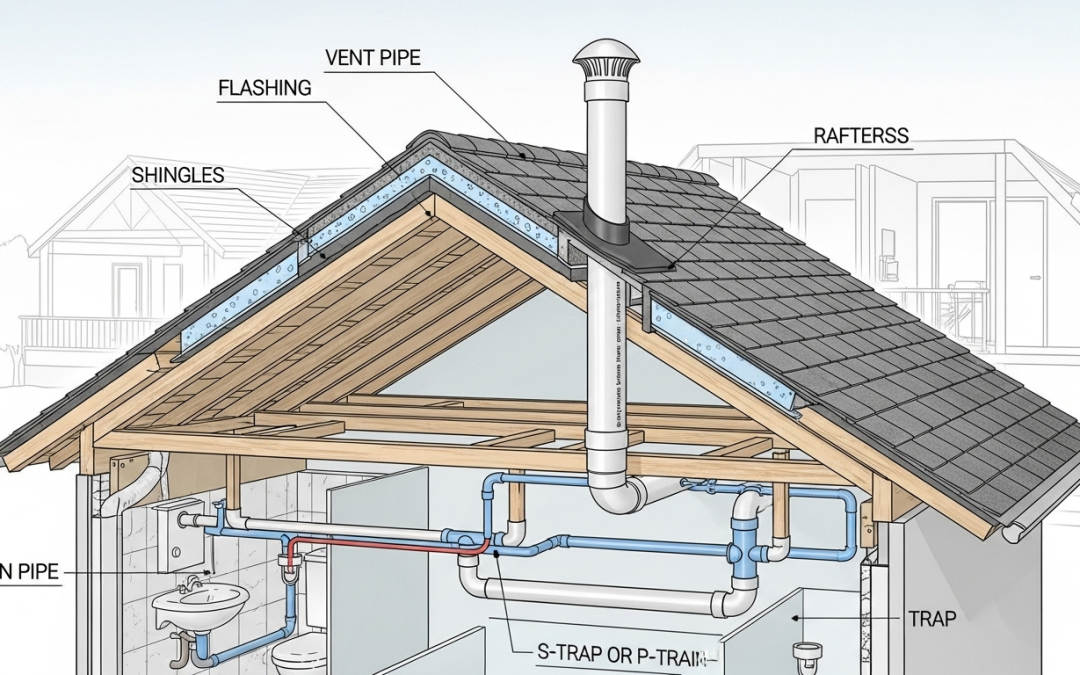When considering your home’s roof, you likely envision shingles, tiles, and gutters. However, there is a less recognized element that serves an essential dual purpose: your plumbing vent. Frequently confused with a small pipe on the roof, this unassuming fixture is crucial for both your plumbing system and the exterior protection of your home.
Grasping this relationship is essential for averting issues that could impact everything from your indoor air quality to the structural soundness of your roof.
What is a Plumbing Vent and What Does It Do?
A plumbing vent, commonly referred to as a vent stack, is the pipe that rises from your home’s plumbing system and extends through the roof.
Its main function is to maintain air pressure within the drainpipes.
As water descends through a drain, the vent facilitates the entry of air into the pipes, thereby preventing the formation of a vacuum.
This guarantees that water flows efficiently and that the water seals in your drains (the P-traps) do not become siphoned out.
In the absence of a properly functioning vent, you would notice gurgling noises emanating from your drains, and more critically, sewer gases would be unable to escape, resulting in them being forced back into your home.
The Roofing-Plumbing Crossover Point
The location where the plumbing vent passes through the roof is a frequent source of problems. The pipe is secured to the roof using a flashing or vent boot, which is a rubber or metal seal designed to keep water out. As time progresses, this seal may degrade as a result of sun exposure, harsh temperatures, and normal wear and tear.
When the vent boot fails, it creates a direct pathway for water to enter your home. This can lead to:
-
Water Damage: Rotted wood, damaged drywall, and stained ceilings in the attic and upper levels of your home.
-
Mold and Mildew: A damp environment perfect for fungal growth.
-
Structural Damage: Compromised roof decking and support beams.
Why a Professional Inspection is Key
Due to the exposure of the vent boot to various weather conditions, it frequently becomes a point of failure. During a thorough roof inspection conducted by a professional roofer, significant attention will be given to the state of these seals. The roofer will examine for any signs of cracks, rust, or deterioration and will replace the boot as necessary. This straightforward preventative action can help you avoid a substantial water damage claim.
Therefore, while you concentrate on the more prominent aspects of your roof, do not forget the unsung heroes—the small pipes that ensure your plumbing operates efficiently and keep your home dry and secure. If you are arranging a roof inspection or observe any indications of an issue, make sure to request that your roofer pays particular attention to these essential, often-neglected components.
Conclusion
In the intricate ecosystem of your residence, every element is interlinked. The unassuming plumbing vent situated on your roof exemplifies this synergy, diligently functioning to safeguard both your plumbing system from air pressure complications and your home’s interior from external elements.
Disregarding this essential connection can result in issues that are as undesirable as they are costly. A qualified roofer understands the importance of examining beyond the visible aspects, assessing not only the shingles and gutters but also the seals surrounding your plumbing vents, chimneys, and skylights.
By recognizing the crucial function of these “hidden” elements, you equip yourself to become a more proactive homeowner. Therefore, when considering your home’s upkeep, keep in mind that safeguarding your roof involves viewing the broader perspective—and meticulously focusing on the minor details that can create a significant impact.

